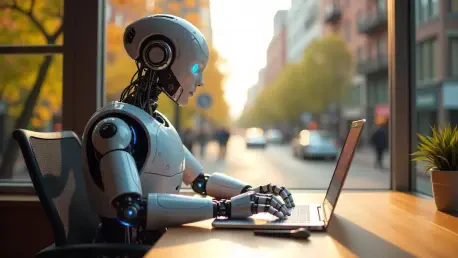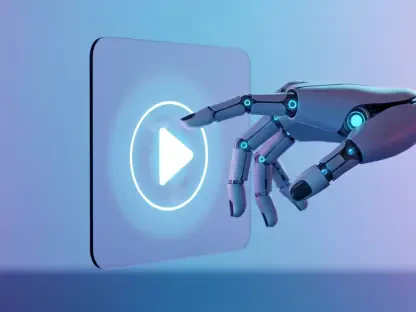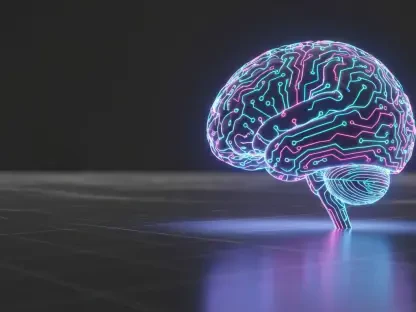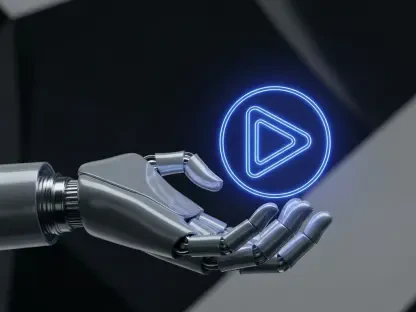Generative AI is at the forefront of technological evolution, fundamentally reshaping creative landscapes by not merely enhancing but transforming how ideas and concepts are imagined and executed. Originally, artificial intelligence concepts were limited to computing efficiencies and data analysis capabilities. However, the generative approach—a specialized branch of AI—has emerged to produce content that rivals the creativity traditionally associated with human thought. This shift is not gradual: it’s a rapidly advancing frontier moving from theory to tangible applications faster than any previous technological innovation. The capacities of generative AI, fueled by sophisticated algorithms and models, have reached a point where they can autonomously create textual narratives, visual art, music compositions, and even complex software code with proficiency often indistinguishable from human creations. This evolution is redefining the parameters of originality and innovation across a spectrum of industries, challenging traditional bottlenecks, and introducing efficiencies once deemed impossible. From business to entertainment, healthcare to education, generative AI’s integration is spawning a new era of creativity that defies conventional methodologies.
The Transformative Power of Generative AI
The transformative influence of generative AI is redefining not only how creative content is generated but also how it is consumed and appreciated in contemporary markets. Historically, creative processes entailed prolonged brainstorming sessions, iterative development, and often serendipitous inspiration—all requiring substantial time and resources. In sharp contrast, generative AI executes these processes in mere seconds, facilitating real-time experimentation and enabling unprecedented productivity. In fields such as finance and healthcare, generative AI’s analytical and synthesis abilities are providing rapid solutions to complex challenges that require nuanced understanding and quick response. Technologies like GPT models have revolutionized tasks involving human-like text generation, solving problems and initiating fundamental breakthroughs in automation and efficiency. These capabilities extend to sectors less traditionally reliant on AI, such as digital marketing, where generative AI assists in creating persuasive ad copies that resonate with target audiences. It adapts and responds to audience sentiment, refining strategies that were once the domain of skilled marketers alone. This blend of creativity and technology exemplifies the profound impact generative AI is having on shaping the evolution of industries.
The professional landscape is experiencing a cascade of innovations prompted by generative AI’s capabilities to automate routine operations while enhancing strategic processes. Software development finds AI-generated code reducing error margins and enhancing creativity, aiding engineers and developers in exploring new concepts without being confined by traditional computational limitations. In fashion and entertainment, generative AI opens pathways to unprecedented creativity, where style and narrative are no longer restricted by past conventions but inspired by AI-fueled experimentation. The swift generation of strategic options provides a breadth of opportunities for innovators to explore ideas otherwise limited by human constraints. For instance, in screenwriting or visual design, AI-generated models enable iterations and refinement at a staggering scale, maintaining high-quality output while managing extensive demands for content. Generative AI stands as a catalyst for creative methodologies that prioritize efficiency without sacrificing quality, reshaping how products are conceptualized and delivered, ultimately redefining the notion of creativity itself.
The Historical Timeline of Generative AI
Generative AI’s development timeline vividly illustrates its exponential journey from niche theoretical applications to widespread practical solutions that have now become staples across diverse industries. The saga began over a century ago with rudimentary applications like algorithmic music generation, which laid the groundwork for complex systems that followed. The journey continued through the mid-20th century when AI was still primarily focused on automating industrial workflows and enhancing computational tasks. By the late 2010s, generative AI achieved groundbreaking developments with neural networks that mimic human cognition, setting the stage for today’s highly sophisticated models.
Notably, the introduction of Transformer models and subsequent neural networks revolutionized AI’s capacity to understand and create contextually coherent content. GPT (Generative Pre-trained Transformer) language models released from 2018 onwards marked significant advancements in natural language processing, enabling machines to generate text with fluidity and context sensitivity that was previously unattainable. These milestones signify not merely technological progress but a paradigm shift in how automation can be integrated into everyday operations across sectors. The rapid evolution came to a crescendo in recent years with tools like ChatGPT and DALL-E, which have democratized access to generative AI’s capabilities, establishing them as critical fixtures in modern-day productivity and creativity.
Generative AI in Art and Creativity Domains
Generative AI has made remarkable strides in artistic endeavors, pushing the boundaries of creative expression and challenging traditional definitions of artistry. Equipped with advanced algorithms, AI tools enable artists to craft visuals that are both original and reflective of intricate emotions, facilitating new levels of visual storytelling. Platforms leveraging technologies such as DALL-E and Midjourney have empowered artists to explore and create without limitations, transforming rudimentary prompts into sophisticated works of art that blend innovation with aesthetic integrity. Using AI as co-creators, artists are no longer constrained by practical challenges like materials, technical skills, or conventional ideation processes. Instead, they are liberated to experiment with forms, colors, and concepts that redefine the landscape of visual arts.
The integration of generative AI into creative fields extends to music composition and voice synthesis, where innovations like MusicLM create audio experiences that are intricate and resonant. By generating music that reflects diverse genres and patterns, AI enriches composers’ portfolios and facilitates new artistic directions. Generative AI’s growing influence also reshapes user interaction with digital entertainment, where personalized content diversification transforms audience experiences. Complex AI-powered algorithms generate bespoke content tailored to individual preferences, enhancing engagement and creating immersive environments that captivate modern audiences like never before. This transformative step reimagines traditional creativity, enabling dynamic interactions and redefining artistic engagement beyond conventional limits.
Innovation and Practical Applications
The practical applications of generative AI stretch far beyond the realms of creativity, creating avenues for innovation that seamlessly blend human and machine intelligence. In healthcare, generative AI’s prowess in analyzing complex datasets assists in the detection of anomalies within diagnostic scans, providing support to medical professionals with precision and speed. Simulation models that replicate molecular interactions open pathways for pharmaceutical developments, expediting processes that were traditionally time-consuming and resource-intensive. These advancements indicate a future where AI-driven innovation plays an integral role in addressing global healthcare challenges. In tandem, industries such as finance and education use AI’s capabilities to summarize lengthy reports, enriching learning modules and presenting data comprehensively without sacrificing complexity.
Generative AI is equally transformative in digital spaces, embedding creativity into software development pipelines, and facilitating real-time coding solutions that adapt to evolving technological demands. Tools like Codex exemplify AI’s role in developing clean, efficient code that aligns with the creative visions of engineers and developers. The integration of AI into platforms such as GitHub Copilot revolutionizes collaborative projects, effectively merging human ingenuity with machine precision. In virtual customer service, generative AI models enhance interaction quality by offering customized responses that reflect user sentiment and contextual needs. From digital art interfaces to interactive game environments, AI-driven solutions continue to redefine industry standards, showing that practical applications are multidimensional and poised to address and enhance creative encounters in diverse settings.
Legal and Ethical Considerations
Alongside the prolific advancements generative AI has heralded, it brings to light intricate legal and ethical considerations that necessitate vigilant attention from regulators and society. Among the most pressing issues are those concerning rights of ownership and intellectual property associated with AI-generated content, which present complex challenges due to AI’s autonomous generation capabilities. Concerns over the ethical ramifications of deepfake technology, which can create maliciously falsified media, prompt urgent discourse about accountability and protections against misinformation. The sophistication of generative AI requires transparent frameworks that safeguard digital identity and uphold information integrity, ensuring ethical usage and prohibiting AI manipulation for malicious purposes.
With AI bias reflecting societal prejudices, the necessity to address the fairness and impartiality of AI models grows paramount. The implementation of mitigation strategies and governance serves to guide AI usage toward equitable outcomes without perpetuating existing disparities. Generative AI’s contribution to job displacement calls for robust policy responses to balance technological progression with workforce stability, fostering symbiotic coexistence between human labor and machine automation. These significant challenges test the limits of legal boundaries and require collaborative efforts from global stakeholders to ensure sustainable development. The regulatory landscape continues to evolve as policymakers strive to adapt to the rapid advances AI presents, shaping a future where innovation remains tethered to ethical responsibility and societal stability.
Sociocultural and Environmental Impacts
Generative AI’s proliferation is reshaping sociocultural landscapes, driving intricate responses within society that reflect both opportunities and challenges. As AI becomes increasingly prevalent, its role concerning creativity and human job prospects evokes discussions about autonomy and the future of work. Concerns over the displacement of creative professionals—such as artists and writers—have grown as AI-generated content becomes more sophisticated, placing pressure on traditional roles and compelling industries to adapt. This shift necessitates thoughtful approaches to redesign concepts of employment and creativity within the AI-augmented world. AI’s influence also extends to the ecological paradigm, where the operational demands of complex AI systems impose considerable resource strain. The environmental footprint associated with computational intensity presents new challenges akin to those in major industrial sectors, underscoring the need for sustainable AI practices and energy-efficient implementations.
The ubiquitous presence of generative AI additionally affects data quality, wherein the dependence on AI-generated information may compromise future AI model training, prompting the risk of “model collapse.” This degradation cycle threatens public datasets critical to AI advancement and calls for strategic intervention in maintaining data integrity. Knowledge gaps and societal biases further exemplify AI’s ability to mirror human flaws, revealing the necessity for continued research and education to guide ethical AI development preserving cultural diversity and fostering inclusiveness. Generative AI’s influence spans beyond technological innovation, impacting cultural narratives and societal norms. The evolution prompts a reflective analysis of humanity’s role amid exponential technological growth, where the essence of human creativity and identity remains an integral part of future landscapes shaped by generative AI’s power.
Concluding Thoughts
Generative AI is revolutionizing the creation and consumption of creative content in today’s market. Traditionally, the creative process involved time-consuming brainstorming sessions, iterative development, and the occasional burst of inspiration—all demanding significant resources. Now, generative AI completes these tasks almost instantaneously, allowing for real-time experimentation and boosting productivity. In finance and healthcare, its ability to analyze and synthesize data delivers rapid solutions for complex issues requiring nuanced insight and quick action. Technologies such as GPT models have transformed tasks needing human-like text generation, pushing the boundaries of automation and efficiency. Even in sectors like digital marketing, not typically reliant on AI, generative AI crafts compelling ad copies by adapting to audience sentiment and refining strategies that were once only the realm of skilled marketers.
This tech-driven creativity is reshaping industries, automating routine tasks while enhancing strategic decisions. In software development, AI-generated code improves accuracy and fosters innovation, aiding engineers in exploring new ideas beyond traditional limits. In fashion and entertainment, AI fuels creativity, allowing for styles and narratives free from past constraints, opening vast opportunities for innovative exploration. Whether in screenwriting or visual design, AI-generated models facilitate endless iterations without sacrificing quality. Generative AI is a catalyst for efficiency-focused creativity, transforming product conception and delivery, ultimately redefining creativity itself.









